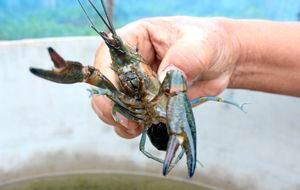Non-native crayfish poses threat to island’s ecosystem
INVASIVE American signal crayfish could spell disaster for local wildlife and an appeal is being made for islanders to report any sightings.

Introduced to UK waters in the 1960s, and bred on farms for the restaurant trade, a handful of escapees have bred and infiltrated river systems from Cornwall to Scotland.
The non-native species has decimated the local crayfish population in the UK.
There are no native crayfish in Guernsey waters, but the voracious predator will eat almost anything it finds, including plants, invertebrates, snails, small fish and fish eggs.
The loss of plants means there are fewer places for insect larvae and for fish to lay their eggs.
The signal crayfish can lay up to 250 eggs a year.
‘The first ones were found about two years ago in a douit,’ said States biodiversity education officer Julia Henney.
‘We are unaware how they got here. One theory is that a local food retailer was serving them and perhaps a customer couldn’t bring themselves to kill and eat it so placed one in a stream.
‘If that crayfish was a pregnant female it could now be populating the waterways.
‘It just shows how careful we must be about what we introduce into our wildlife.’
The issues continue as the crayfish will dig burrows up to 3ft long in river banks, which increases the risk of collapse.
The crayfish is extremely aggressive, encased in a tough shell and armed with two large pincers.
‘The American signal crayfish are unmistakeable,’ said Miss Henney.
‘They look like nothing else we have here in our streams, they are about eight to 10 centimetres long and are a brownie green colour. They are like a small lobster.
‘What we are asking is for anyone who catches one to make sure they don’t release it and get in contact with the States and let us know where you found it.
‘Our hope is we can wipe out the problem now before it becomes too much of an issue.
‘Getting them at this early stage is essential.’
Jason Jehan, water production scientist for Guernsey Water, said: ‘We plan to assist the biodiversity officer in the detection and possible collection of the crayfish.
‘They do not currently represent threats to the water quality or operations.
‘We found several a few years ago in a stream filter bag, but subsequent attempts to catch individuals were unsuccessful.’





